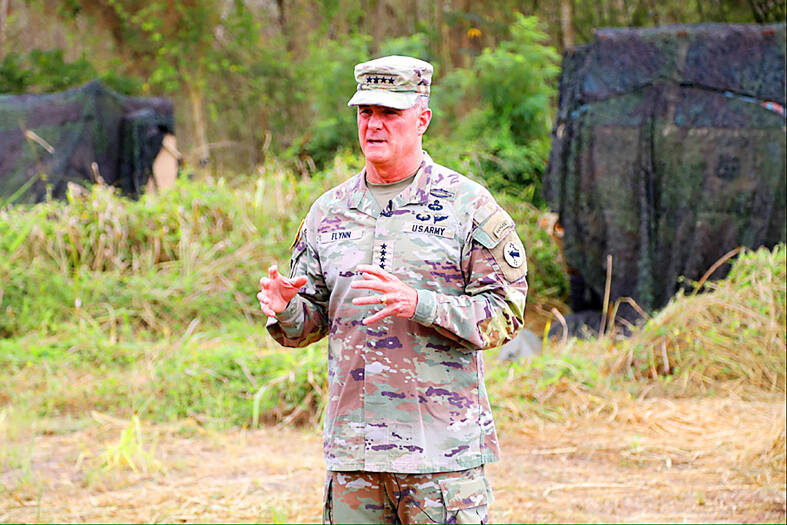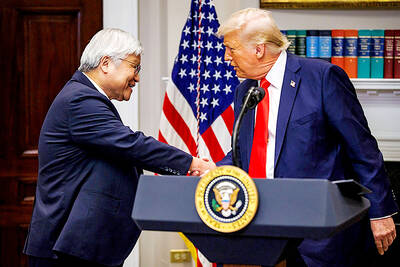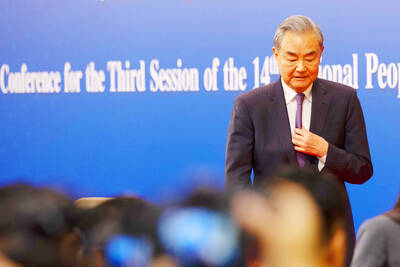The US is to deploy newly developed missiles to the Indo-Pacific region this year with additional types planned for later, a top US commander told a news conference at the US embassy in Tokyo on Wednesday.
“I am not going to discuss what system and I am not going to say where and when,” General Charles A. Flynn, commander of the US Army Pacific, was quoted by Stars and Stripes as saying at the event. “I am just saying there will be a long-range precision fire capability.”
Deployment of land-based medium-range missiles that are capable of being armed with nuclear warheads in the region would be a first for Washington since it suspended the Intermediate-Range Nuclear Forces Treaty in 2019.

Photo: AFP / US Army
Previously, Flynn told reporters at the Halifax International Security Forum in Canada that the US would deploy a limited number of Tomahawk missiles and Standard Missile-6 (SM-6) to the region, Defense One said in a report on Nov. 19 last year.
The US Army’s new land-based Tomahawk cruise missiles have a range of more than 2,400km and can be utilized to strike ground and sea targets.
In Tokyo, Flynn was cited as mentioning the Typhoon launcher, a system being developed for the two missile types, saying that it would have a “hypersonic capability.”
“I am not going to say where or when we will deploy in 2024,” Flynn said. “There are actually multiple systems in development.”
He also spoke about the Precision Strike Missile, a long-range anti-ship weapon expected to reach initial operational capabilities by the end of the year.
According to Lockheed Martin, the missile can engage targets at ranges beyond 499km.
Washington does not deem it necessary to sign new agreements with other countries to deploy medium-range missiles, Flynn said, adding that the US Army already deploys High Mobility Artillery Rocket Systems in the region.
Separately, the Financial Times reported on Thursday that Tokyo and Manila have discussed deploying Japan Self-Defense Forces in the Philippines as the countries verge on several security pacts aimed at augmenting the region’s defense against China.
Philippine Ambassador to the US Jose Manuel Romualdez was cited as saying that Manila and Tokyo were close to inking a “reciprocal access agreement,” which would allow their militaries to train and conduct drills on each other’s territory.
The two countries additionally made plans to deploy troops on a rotation, similar to the arrangement that enabled the US to maintain a continuous presence in the Philippines, despite the latter’s constitutional prohibition against permanent basing of foreign troops, he said.
Japan and the Philippines are anticipated to ink the reciprocal access agreement shortly after their heads of state attend a trilateral meeting hosted by US President Joe Biden, he said.

CRITICAL MOVE: TSMC’s plan to invest another US$100 billion in US chipmaking would boost Taiwan’s competitive edge in the global market, the premier said The government would ensure that the most advanced chipmaking technology stays in Taiwan while assisting Taiwan Semiconductor Manufacturing Co (TSMC, 台積電) in investing overseas, the Presidential Office said yesterday. The statement follows a joint announcement by the world’s largest contract chipmaker and US President Donald Trump on Monday that TSMC would invest an additional US$100 billion over the next four years to expand its semiconductor manufacturing operations in the US, which would include construction of three new chip fabrication plants, two advanced packaging facilities, and a research and development center. The government knew about the deal in advance and would assist, Presidential

‘DANGEROUS GAME’: Legislative Yuan budget cuts have already become a point of discussion for Democrats and Republicans in Washington, Elbridge Colby said Taiwan’s fall to China “would be a disaster for American interests” and Taipei must raise defense spending to deter Beijing, US President Donald Trump’s pick to lead Pentagon policy, Elbridge Colby, said on Tuesday during his US Senate confirmation hearing. The nominee for US undersecretary of defense for policy told the Armed Services Committee that Washington needs to motivate Taiwan to avoid a conflict with China and that he is “profoundly disturbed” about its perceived reluctance to raise defense spending closer to 10 percent of GDP. Colby, a China hawk who also served in the Pentagon in Trump’s first team,

SEPARATE: The MAC rebutted Beijing’s claim that Taiwan is China’s province, asserting that UN Resolution 2758 neither mentions Taiwan nor grants the PRC authority over it The “status quo” of democratic Taiwan and autocratic China not belonging to each other has long been recognized by the international community, the Mainland Affairs Council (MAC) said yesterday in its rebuttal of Beijing’s claim that Taiwan can only be represented in the UN as “Taiwan, Province of China.” Chinese Minister of Foreign Affairs Wang Yi (王毅) yesterday at a news conference of the third session at the 14th National People’s Congress said that Taiwan can only be referred to as “Taiwan, Province of China” at the UN. Taiwan is an inseparable part of Chinese territory, which is not only history but

INVESTMENT WATCH: The US activity would not affect the firm’s investment in Taiwan, where 11 production lines would likely be completed this year, C.C. Wei said Investments by Taiwan Semiconductor Manufacturing Co (TSMC, 台積電) in the US should not be a cause for concern, but rather seen as the moment that the company and Taiwan stepped into the global spotlight, President William Lai (賴清德) told a news conference at the Presidential Office in Taipei yesterday alongside TSMC chairman and chief executive officer C.C. Wei (魏哲家). Wei and US President Donald Trump in Washington on Monday announced plans to invest US$100 billion in the US to build three advanced foundries, two packaging plants, and a research and development center, after Trump threatened to slap tariffs on chips made